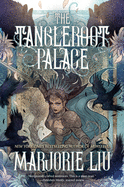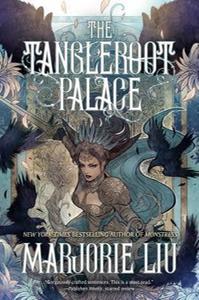
 In The Tangleroot Palace, Marjorie Liu gathers six previously published short stories and an original novella in a powerful collection of speculative fiction, showcasing the talent that's won her several Eisner and Hugo awards. With a range of themes and settings, the stories in The Tangleroot Palace showcase immersive world building and emotionally evocative prose, the same writing that has made her so successful in her paranormal romance novels and in powerhouse comics like Monstress (with Sana Takeda).
In The Tangleroot Palace, Marjorie Liu gathers six previously published short stories and an original novella in a powerful collection of speculative fiction, showcasing the talent that's won her several Eisner and Hugo awards. With a range of themes and settings, the stories in The Tangleroot Palace showcase immersive world building and emotionally evocative prose, the same writing that has made her so successful in her paranormal romance novels and in powerhouse comics like Monstress (with Sana Takeda).
The collection opens with "Sympathy for the Bones," a story best described as creepy, in which a woman just crossing into adulthood murderously breaks free from the woman who has been her savior and captor for most of her life. The book ends with the titular novella, which reads like a fairytale, complete with a dangerous enchanted forest, an unwanted betrothal and an alluring stranger. In between are five stories varying widely in subject, but united by the same themes and archetypes readers will recognize from Liu's other work. She focuses on people, mostly women, who are morally gray. Monsters with good motivations, humans who do monstrous things, women doing whatever they must for freedom and revenge.
Liu's love of fairytales and superhero stories shows throughout. In "The Last Dignity of Man," a character who styles himself as Lex Luthor has built an empire based on biotech, and "There is no Superman. Alexander must be his own moral compass."
Featuring two women overcoming oppression, Liu's subversive "The Briar and the Rose" best captures the essence of the collection. It's a sapphic retelling of Sleeping Beauty and directly addresses the sexual assault and lack of female agency in the source material. As with each of the stories, Liu discusses the original project for which she wrote the story--in this case a collection of "fresh takes on old fairytales"--and the motivation for her plot and character choices. Though the book would be complete without them, these notes from the author add context and connect readers to the stories as well as to the time in which Liu wrote them.
Introducing the collection, Liu remarks that she noticed her stories are connected by a few common threads, but one lingers long after reading. Writing in the midst of the Covid-19 pandemic, she notes that "hope in the possibility of something good--even the tiniest, most wee little good--is sometimes all we've got." While The Tangleroot Palace is certainly not lighthearted, that thread of hope guides everyone through even the darkest of times. --Suzanne Krohn, editor, Love in Panels
Shelf Talker: Marjorie Liu collects seven darkly fantastic stories in The Tangleroot Palace, showcasing immersive world building and emotionally evocative prose.

